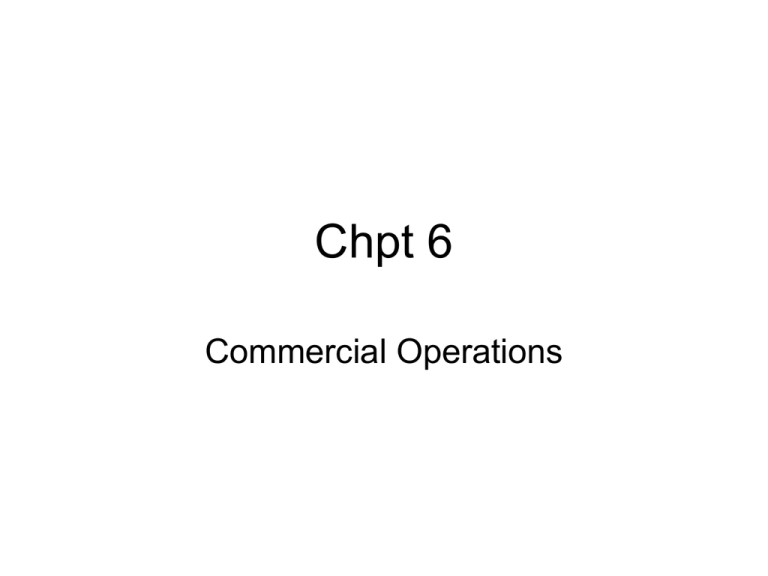Part 1
advertisement

Chpt 6 Commercial Operations Big Picture • Part 1 (today’s presentation) will focus on commercial media and corporate structures in general. A bigpicture approach. • There are some general business concepts that could be a little mind boggling, so TAKE GOOD NOTES AND READ THE TEXT BOOK! • The second part (next class) will break down organizational structure, advertising, subscription fee structure • All of the above topics are in the text. Have the chapter read by NEXT CLASS. You will be expected to know about these concepts. I will ask you. Public Service/BBC vs Commercial Models • Public service – Seeks to please pluralistic tastes free from commercial interests – Revenue from licensing fees – The goal is public service, especially when it comes to journalism – Relative monopoly • Commercial – Seeks to attract audience through marketable news and entertainment programming – Revenue from advertising and/or subscription fees (for pay cable and PPV) – The goal is marketability, even in the case of journalism – No monopoly Do we have a more free media? • So since the BBC model is a relative monopoly and not market driven, does that mean the market system is better? • Since we have a number of broadcast journalism majors, which model do you think provides better journalism? Media Concentration • Traditionally broadcast and cable are seen as two separate sectors with different organizational structures. • True to an extent (see the differences in organization in text) • But multiple-system operators (MSOs) and a trend toward vertical integration concentrates media ownership into a very small group of entities. Multiple System Operators (MSOs) • There were no cable ownership limits in place until 1992, so cable companies were able to grow larger and larger • Throughout the 1990s and 2000’s, cable companies have been challenging limits on “horizontal” integration (ownership) Vertical vs Horizontal Integration • What the heck does that mean? • “Horizontal” and “Vertical” integration are business management terms describing types of ownership and control. • Horizontal Integration means when a company takes over another company in the same industry. Imagine the horizontal line being companies that do the same thing and companies in the vertical line are related companies • So if a big cable operator (like Comcast) buys a smaller one (like Adelphia) that is considered “horizontal.” If Comcast buys a production company, that would be considered “vertical” because it is related but exists in a different part of the production chain. Vertical vs Horizontal Integration • If it helps, think of Coca-Cola • All of its competitors are horizontally connected (Pepsi, Snapple etc…) • The corn-syrup plant that produces its sweetener, the can manufacturing company, the shipping business that gets cans of Coke from Scranton, PA to Toronto, Canada are all vertical. Get it? Multiple-System Operators (MSOs) • We’re back to this again? Yes. • So what happened is that cable operators were making more and more money and they were buying other cable systems. • Even with some FCC limits, this trend increased in the 1990s • Currently, the top 25 MSOs serve 90% of ALL cable subscribers in the US. • On top of that, MSOs tend to try to form “clusters.” Clusters form when multiple cable systems combine in a geographic area. • http://www.ncta.com/Stats/TopMSOs.aspx Vertical Integration • This is linkage between program production, distribution and delivery. • Huh? • Think Time Warner. Time Warner • Second largest MSO (after Comcast) with over 13 million subscribers • Time Warner merged with Turner Broadcasting Systems (TBS) in 1996. • Current TBS assets include current assets include CNN,HLN,TBS, Turner Network Television, Cartoon Network, Adult Swim, Boomerang, NBA TV, TruTV, Turner Classic Movies, and over-the-air Atlanta station WPCH-17 (formerly WTBS), and a bunch of other stuff including movies and video games. • Time Warner also has partial ownership of CW • Time Warner and Competitor News Corp Competition? • This is happening across all media • In radio, for example, some markets have 8 “competing” stations all owned by the same company. • In NY, news radio competitors WCBS and 1010 WINS are owned by the same company (CBS Radio, formally Infinity) which is owned by CBS, which was split from Viacom, but both are controlled by National Amusements. • Plus in 2007 the FCC overturned a “cross-ownership” ban and allowed broadcasters in the country's top 20 media markets to own a TV or radio station and a newspaper in the same market. What this looks like • Some of this information is a few years old, but the point is the same: – Media Channel’s Chart (from about 2000) http://www.mediachannel.org/ownership/chart.shtml – The Nation’s Big 10 (from 2002) – http://www.thenation.com/special/bigten.html – CJR’s Who Owns What (this is up to date) : http://www.cjr.org/resources/ – Common Cause’s Timeline of Media Mergers (up to 2006) http://www.commoncause.org/site/pp.asp?c=dkLNK1MQIwG &b=4923181 – Well Connected Interactive Map (up to date) http://projects.publicintegrity.org/telecom/default.aspx Bill Moyers • This piece aired in 2007 before cross ownership ban was lifted: – http://www.pbs.org/moyers/journal/121420 07/watch2.html Opinions? • This is the part of the class where you show off your critical thinking skills.






